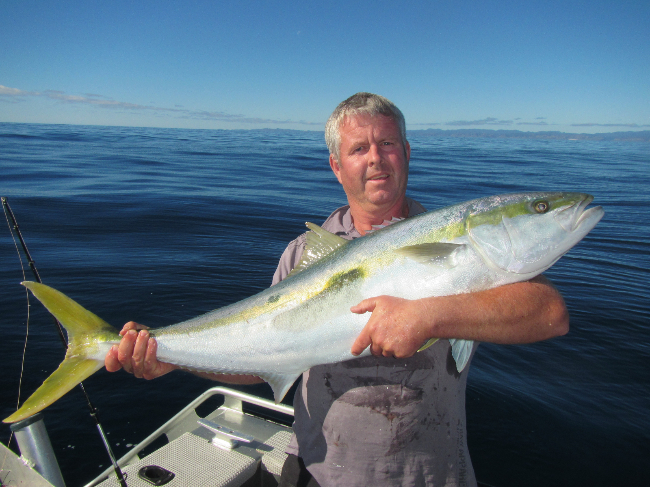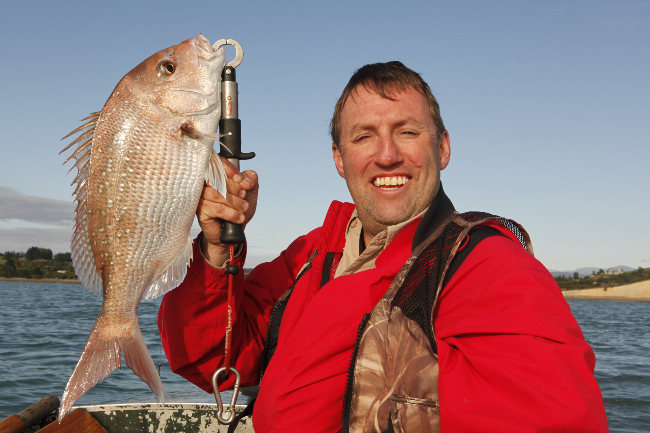Home > Fishing Charters > Saltwater Fish Species

|
SEEKING ADVENTURE? |
|
Saltwater Fish Species
 |
 |
Zane Mirfin understands these resources like few others, and as a 6th generation local sports fisherman, and professional fishing guide since 1985, knows how to help you achieve the best results possible.
Kahawai
A plentiful and aggressive silver-sided pelagic fish, that eats almost anything and fights like crazy. Arguably New Zealand’s most accessible and popularly caught sport fish. Kahawai occupy a wide range of saltwater habitats and can be caught year-round, often in big numbers. Ranging from open water surface schooling behaviour, to estuaries, rivermouths, harbours, surf beaches and deeper reefs they can be caught by virtually any method including bait, soft plastics, trolling, casting, jigging, poppers, flies. A reasonable table fish they are most commonly in the 1-4kg size bracket.
Snapper
New Zealander’s have always had a love affair with the mighty snapper that is a common fish in the northern South Island. Snapper occur across a broad range of habitat including reefs, estuaries, and mussel farms and are most commonly caught over the warmer summer and autumn months, but can be caught year-round in deeper and more remote waters. Change of light in the morning and evenings are the best times and snapper will eat bait, jigs, soft baits, and flies.
Blue Cod
A favourite eating fish, blue cod can be caught year-round on reefs and foul ground with bait, jigs, soft plastics, and flies. Beautifully coloured fish, the bag limit for blue cod is now two fish per angler over 33cm.
Red Gurnard
Gurnard are our go-to fish throughout the year, both winter and summer. Stunningly beautiful with orange sides and huge blue pectoral fins, gurnard are second to none on the dinner plate. Often nicknamed “carrots” they congregate over the sand and shell seafloor and are highly susceptible to jigs, flies and bait. Overseas anglers love these exotic fish caught on light sporting tackle.
Tarakihi
Another year-round target species, tarakihi or ‘turkeys’ as they are often known live over reefs and foul ground, often in large groups. Berley use is a standard technique to attract tarakihi and these clean silver-sided fish tug hard on the line and are a fine table fish.
Yellowtail Kingfish
Definitely the toughest pound-for pound fishing opponent in the sea, ‘kingies’ are aggressive predators that can be caught by trolling, live-baiting, soft plastics, jigs, and even fly fishing from boats or wading the intertidal ‘flats’. A handsome fish with a dark back, silver sides, and distinctive yellow tail, kingies are a challenging fish to target over warmer summer and autumn months.
Albacore Tuna
Also known as ‘alberts’, albacore are the chicken of the sea with tasty white flesh and are commonly caught up to 10kg. Best caught trolling in the blue water, tuna can also be caught on jigs and maybe even a fly rod. Only present in the warmer summer and autumn months, albacore hit hard, rip line, and sound deep under the boat.
Trevally
You’ll know when a trevally hits your jig because they are some of the best fighters in the sea. With broad muscular sides, these silver fish can be caught deep, at mid-water, and sometimes surface shoaling on small krill and baitfish. Not bad eating, big ‘trevs’ are often the highlight of a sport fishing day.
Mackerel – Koheru / Jack / Blue
Mackerel can be present in big numbers and are highly susceptible to small jigs and flies. Some of the bigger specimens are 1-1.5kg and it is common to catch multiple fish at a time. Especially fun when big ‘meatballs’ are up on the surface, and who knows what is hunting them from below?
Squid / Octopus
Squid are a common catch on jigs and flies and make great eating. Octopus are a novelty catch and make exceptional bait.
Barracouta
Often described as the curse of the seas, barracouta have fearsome teeth and appetites demolishing plenty of terminal tackle and lines. We love’em – they’re long and silver, fight well on light tackle, and can be caught year-round by virtually every method. Best released alive to fight another day.
Hapuku / Groper
Mostly caught in remote and extremely deep water, groper make excellent eating. Caught on bait, jigs, and soft plastics. Occasionally groper show up in inshore waters.
Sharks – Tope / Rig / Spiny Dogfish / Carpet Sharks
Tope, school sharks or ‘grey boys’ are one and the same thing. Sometimes they get quite big and can really put a bend in a rod and pull some serious string. They’re a good table fish too, much like rig or lemonfish which are more commonly caught in set nets.
Spiny Dogs or ‘spikies’ aren’t a target fish but can be caught in plague proportions at times. Great for the kids to get excited about catching fish. Carpet sharks are likewise not targeted but part of the fishing experience at times. Both of these species can largely be avoided by fishing artificial lures or flies.
Flounder
Occasionally we catch a flounder on a rod, especially when out fly fishing. Most flatfish species are caught in 9 mesh high flounder set nets designed to hug the bottom to minimise bycatch. Drag netting with several anglers working as a team in low-tide channels and on sand beaches is effective and fun. Flounder make excellent eating, either cooked whole or filleted.
Whitebait
Well regarded as a legendary New Zealand delicacy, whitebait are small transparent juvenile fish that ascend rivers via coastal estuaries each spring. Actually 5 separate species of native fish make up the generic name ‘whitebait’ but they are all delicious pan-fried in fritters or ‘patties’. Caught in fine meshed trap nets, both scoop and sock nets have their place. It’s exciting stuff, even addictive, as you spot ascending schools of ‘bait’ moving upriver toward your waiting net during the September / October fishing season.
Scallops / Oysters
Scallops are a first rate seafood, and this shellfish delicacy can be caught by either diving or by dredge towed behind the boat. Dredge oysters are great fare too, and both species can be caught together at the same time, and be combined with a rod- fishing trip.
Mussels / Cockles
Wild mussels grow on coastal rocks but the best tasting mussels are the green shelled marine farmed variety. Cockles are easily gathered by hand and rake on tidal flats in Golden Bay.
Crayfish / Paddle Crabs / Paua
Crayfish are commonly caught by diving but mesh pots set overnight also work well. Crabs are caught on sandy beaches in crab pots. Paua are an abalone, with a brightly coloured iridescent inner shell that are best harvested by free diving but can also be harvested by hand off the rocks during low spring tides.
Other Fish we catch: Stargazer, skate, eagle ray, elephantfish, conger eel, red cod, piper, john dory, sea perch, goatfish, butterfly perch, blue moki, grey mullet, yellow-eyed mullet, spotty, banded wrasse, butterfish, parrot fish, sole, warehou, leatherjacket…
Striped marlin have been seen off Farewell Spit in Golden Bay, and as our coastal waters continue to warm, the fishery should get even better with new varieties of fish making an appearance.





